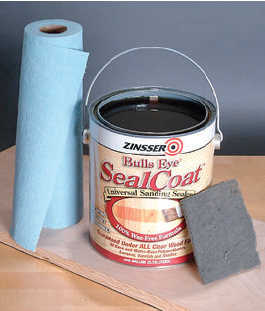
In a recent Q&A there was a question about multiple coats of stain. The response was, when the desired color is obtained, to apply a seal coat by wiping on poly. I’ve found that if I use multiple coats of stain and then use a solvent-based poly sealant that I redissolve the stain and lose some of the color by picking it up on the rag. If I use a latex-based seal coat, that is avoided. Do you have any other suggestions to avoid redissolving stain? – Roger Kaas
Chris Marshall: If the stain and topcoat use the same solvent as a base, the solvent in the poly (mineral spirits) can re-suspend some of the pigment in the stain, which also reacts with mineral spirits. But two dissimilar solvents won’t have the same effect — mineral spirits vs. water. This same-solvent problem is minimized if you wait until the stain is fully dry (which can take several days or more until the oil evaporates completely) and you don’t rub the poly over the stained surface vigorously; but this still a good point of potential concern you raise here. We should have mentioned that possibility in the original responses to the question. Here’s another alternative sealer coat that can help: de-waxed shellac. Zinsser’s SealCoat™, which is commonly available at most home centers, makes an excellent sealer over almost anything. Use it full strength from the can. Once it cures (and it cures quickly!), you can topcoat with whatever you like: more shellac, varnish of any kind or lacquer. The stain will be locked beneath the first coat of shellac. Be careful, however, not to use shellac with wax in it. That can cause adhesion problems with the topcoat.
Tim Inman: Now we’re into the ART of fine finishing! My delight. Your observations are correct and, informed with this information, you can do things artistically to avoid the problem — or use the knowledge to increase your skills in finishing. First, to avoid the problem of resolubilizing and pulling off some of your hard-earned color, the best answer is to simply spray on a sealer coating. By spraying, you completely eliminate the possibility of pulling or dragging colors. Spraying requires more attention to safety, and may give you the excuse to go out and buy some new equipment. Aerosol “rattle cans” of finish can be used if you aren’t ready to purchase spraying equipment. Aerosol shellac is a great product to use for quick or limited needs in sealing in finishes. Once your colors are locked, you could then go on to brush or wipe the final coats.
Using inter-layers of finish material which are not affected by the chemistry of the coat above or below them is a good way to lock in or “seal” your work. A coating of a latex or water-based material would be called a “neutral barrier” coating. It works.
Being able to redissolve and soften finishes, especially colors, is a great way to add accent and interest to finishes. Some refer to pulling off selected areas of color — or selected amounts of it — as “negative” painting. You’re removing or subtracting the color, rather than adding it. This can create or accent grain highlights, carvings and moldings, etc. The process of using glazes in furniture finishing is the best example of intentional “negative” color work. Glazes are typically used between layers of finish rather than on the bare wood.
Just as a point of interest, if you’re a reader: Glazes referenced in “fine art” texts are transparent washes. Glazes discussed in books aimed at the furniture trades are opaque. Failing to know this little tidbit can really cause you a headache if you’re reading about porcelain, and trying to apply that information in the furniture shop.
I’m personally thrilled to see this question. So often, questions about finishing fine furniture go to the chemistry of the process. While it is good to know your materials, it is the art of the work that truly distinguishes one fine finish from another. I’ve contended for a long time that one should not be able to identify the chemistry of the finish from the look of it. Being able to get your color exactly as you want it, and then seal it in and protect it from the next steps is more art and skill than chemistry. Practice your techniques, and create a beautiful finish on your next project!
I’m biased, of course. My book, The Art of Fine Furniture Finishing, discusses these techniques and others in more detail.





